Their SOPs transformed my workflow: clear research guidelines kept me focused, templates halved drafting time, and QA checklists caught errors before clients saw them.
When I returned to freelancing, I created my own streamlined SOPs that keep my work consistent and professional — all without corporate bloat.
For writers, SOPs aren't creativity killers; they’re like personal assistants, handling the routine so you can focus on crafting great content.
By the end of this guide, you‘ll have the tools and insights to write SOPs that save time, eliminate errors, and scale your productivity. You’ll even discover top templates and tools to make implementation effortless.
Table of Contents
What is an SOP?
A standard operating procedure is a comprehensive step-by-step guide on how to perform a routine task. Managers can save time on training by sharing SOPs, and employees can refer to them for sequential instructions when executing specific tasks.
Types of SOPs
SOPs fall into three main categories: technical, administrative, and quality control.
- Technical SOPs guide precise operations like software deployment or equipment setup. For instance, when you need to standardize your website updates, create a technical SOP that reduces deployment errors.
- Administrative SOPs streamline business processes such as invoice handling and client onboarding. I have found them valuable for these tasks and for email management. I witnessed how the agency's administrative SOPs successfully reduced client onboarding time from two weeks to just three days.
- Quality control SOPs ensure consistent standards across work delivery, whether that's content creation, manufacturing, or service delivery. They help ensure every output meets your standards. When our team started following the new QC SOP, our client revision requests dropped by 60%.
When to Create an SOP
Through my experience using SOPs at the agency and later adapting them for my freelance work, I've learned that an effective SOP can transform chaos into clarity.
In my experience, these documents prove most valuable when consistency directly impacts success. They remove the guesswork from complex processes, making them easier for everyone involved.
For example, customer support teams rely on SOPs to ensure complaints are resolved efficiently and fairly.
Content teams use them to keep publication workflows on track, and finance teams depend on them to streamline payment processing.
Based on my experience, here are the tell-tale signs you need an SOP:
- When a task requires multiple people to complete it consistently.
- If errors in the process could have serious consequences.
- When you find yourself repeatedly answering the same process questions.
- If regulatory compliance is involved.
However, I've also learned that not every process needs an SOP.
For simpler tasks like checking emails or organizing files, I've found a basic checklist often does the job better. The key is matching the level of documentation to the complexity and importance of the task.
What should an SOP include?
An effective SOP isn’t just a checklist — it’s a tool for clarity and consistency. To ensure your team can rely on it, every SOP should include a few essential components that make it actionable, easy to understand, and repeatable.
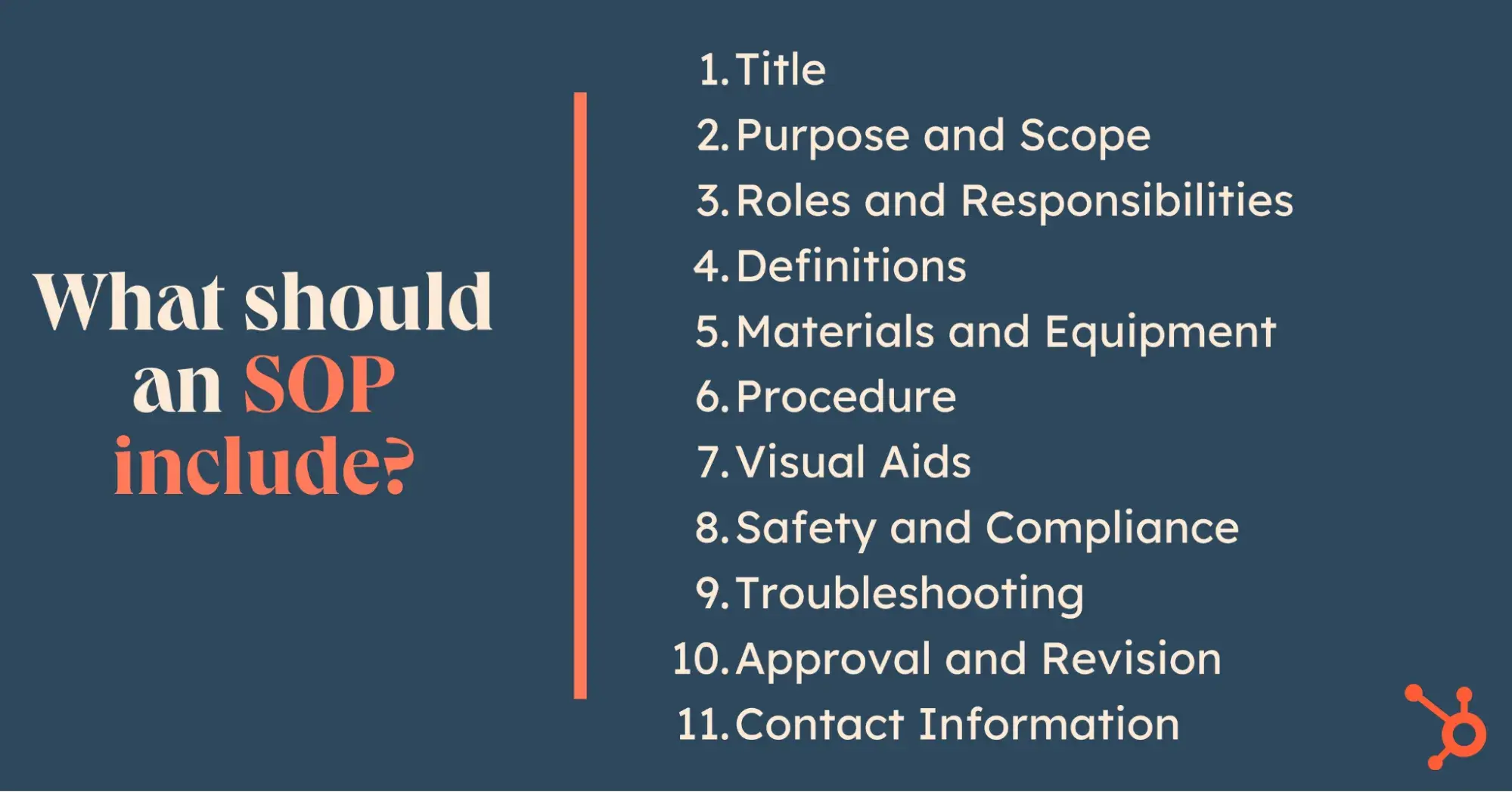
Let’s break down these components and explore why each one is essential.
1. Title
The SOP should start with a clear, descriptive title that immediately tells the users what it's about. Here’s how your title should look.
Template: [Task Name] + [Department] + “SOP”
Example: Blog Post Review Process - Content Team SOP
2. Purpose and Scope
This section briefly explains why the SOP exists, who the SOP is for, and what it covers.
Be specific about the tasks and processes it addresses. Think: What goal does it achieve? Is it for a certain department or the entire organization? This helps employees understand its importance and relevance to their work.
Template: This SOP helps [target user] to [complete task] by [method] to achieve [goal]
Example: This SOP guides content team members through the blog publication process, from the final draft to the live post. It covers WordPress publishing, SEO checks, and social media scheduling. This process applies to all blog content except news articles and product releases.
3. Roles and Responsibilities
For easy identification, place this information near the top of the document.
Include relevant ID numbers, department names, and necessary signatures. Additionally, list the roles involved in the procedure and clarify their responsibilities.
This helps avoid confusion or conflict regarding who needs to do what. Include a concise responsibility matrix that outlines the primary owner, secondary support, approvers, and end users.
|
Role |
Responsibility |
|
Content Writer |
Submits final draft, implements editor feedback |
|
Editor |
Reviews content, performs SEO check |
|
Content Manager |
Final approval, schedule publication |
|
Social Media Team |
Creates and schedules promotional posts |
4. Definitions
List key terms that readers need to understand to follow the procedure correctly. Include:
- Technical terms specific to the task.
- Acronyms and abbreviations used in the document.
- Industry-specific jargon that requires explanation.
Here’s an example of what that might look like.
- CTA: Call-to-action (a prompt that encourages readers to take a specific action).
- KPI: Key performance indicator (metrics used to measure content success).
- SEO: Search engine optimization (techniques to improve content visibility in search results).
- Style Guide: A document outlining writing standards and formatting rules.
Pro tip: Keep definitions brief and relevant to the procedure only. Organize them alphabetically for easy reference.
5. Materials and Equipment
This section should state all resources needed to complete the procedure. Include any tools, equipment, software, materials, or access permissions.
For example, in an SOP on “Scheduling Social Media Content,” the materials section would state the following.
- Required Access: Social media management platform (HubSpot’s Social Media Management Software in Marketing Hub), brand asset library.
- Software: Meta Business Suite, current version.
- Resources: Social media calendar, approved hashtag list, content approval form.
Keep the list clear and specific so users can gather everything needed before starting the procedure.
6. Procedure
This section should outline each step of the process in a clear, logical sequence.
Begin each step with an action verb and include any necessary details, branching paths, or conditional steps. Complex procedures may require sub-steps or decision points.
Building on our earlier example, an SOP on “Scheduling Social Media Posts,” the procedure section would state:
- Open HubSpot scheduling dashboard.
- Select the appropriate social channel.
- Upload media content (If video: Verify format compatibility. If image: Check that dimensions match platform requirements.)
- Write post caption following brand guidelines.
- Add approved hashtags.
- Set publication date and time.
- Submit for required approvals.
- Verify scheduled post appears in the content calendar.
Present the steps chronologically and specify any variations or decision points. Include cautionary notes or tips where relevant for process clarity.
7. Visual Aids
Use images, diagrams, or screenshots to illustrate the steps. Visual aids can make complex processes easier to understand and follow. Like this:

8. Safety and Compliance
Highlight any safety precautions or regulatory requirements. Make sure employees are aware of any hazards, along with what needs to be done to handle them safely.
9. Troubleshooting
Provide solutions for common problems that might arise during the procedure. This section can save time and reduce frustration by helping employees resolve issues quickly.
10. Approval and Revision
Include a section for approvals, noting who has reviewed and approved the SOP.
Also, add a revision history to track updates and changes over time. This ensures the SOP remains current and accurate.
11. Contact Information
Offer contact details for someone who can answer questions or provide further guidance. This ensures employees know where to turn if they need help.
Pro tip: Before writing any SOP, gather examples of similar procedures that have worked well in your industry. This can provide valuable insights into what information to include and how to structure it effectively.
What does an SOP look like? [Free Template]
A standard operating procedure template gives you a clear, organized format to follow. This makes the process of creating SOPs faster.
HubSpot's free SOP template, for instance, outlines tasks and processes for your team. It includes sections like purpose, scope, procedures, and responsibilities.
You can customize it with your company logo and add charts or diagrams in the appendix.
This user-friendly template makes sure your SOPs are comprehensive and easy to understand.
Get Your Free SOP Template Here
How To Write an SOP
- Identify and prioritize processes and objectives.
- Define the end-user.
- Determine the stakeholders and creators.
- Determine the scope and format.
- Gather information.
- Outline and write the SOP.
- Proofread, test, and revise.
- Implement and regularly update.
Creating an effective SOP doesn't have to be overwhelming. By breaking it down into manageable steps, you can develop clear, useful procedures that your team will actually want to follow.
Let’s look at these steps in detail.
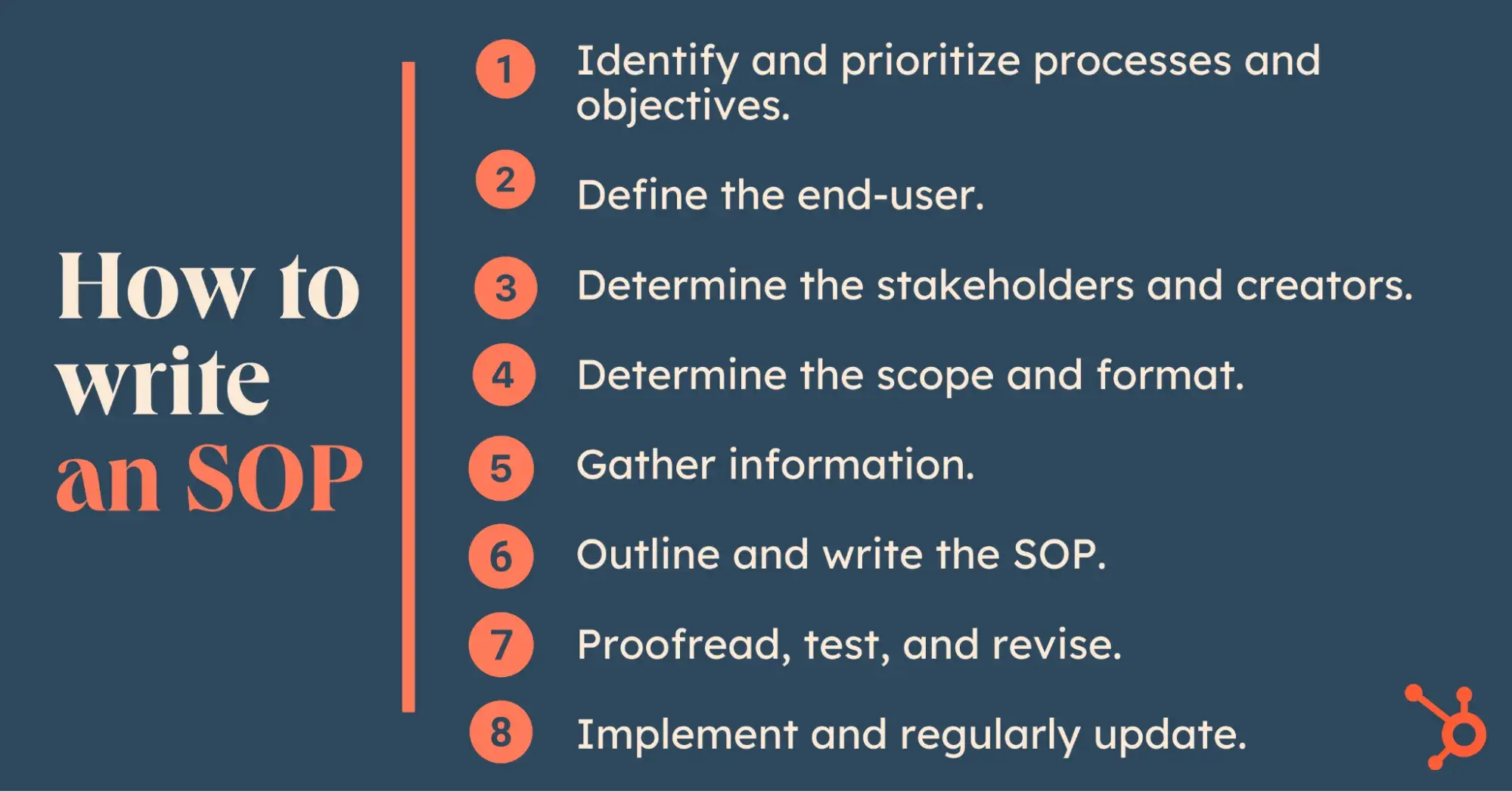
Step 1: Identify and prioritize processes and objectives.
When I began creating SOPs, I learned quickly that trying to document everything creates overwhelm and inefficiency.
Start by identifying which processes most urgently need standardization. I recommend evaluating your workflows by asking three key questions:
- How can the SOP improve efficiency and teamwork? Consider current bottlenecks and how clear, well-documented steps could streamline operations.
- What will customer service look like with everyone following the SOP? Reflect on the potential improvements in customer satisfaction when your team follows the standardized procedures.
- How will the SOP boost the company’s bottom line? Think about how consistent processes can lead to cost savings, better resource allocation, and increased productivity.
Identify workflow issues and list departments that would benefit from SOPs, such as finance, legal, HR, customer service, and IT. Then, within each department, pinpoint critical tasks to be performed accurately to avoid issues.
Here’s what that could look like.
- Finance: Budgeting, financial reporting, payroll.
- Legal: Contract review, compliance audits.
- HR: Recruitment, onboarding, evaluations.
- Customer service: Inquiry responses, complaint handling.
- IT: Software installation, network maintenance.
Document each process with its name, department, purpose, and key steps.
For example, in public relations, the process of writing press releases should include steps like researching the event, drafting the release, reviewing it, getting approval, and distributing it.
This ensures your SOPs are comprehensive and targeted at improving critical areas.
I also recommend holding brainstorming sessions with team members to capture all relevant tasks and finalize SOP objectives.
Pro tip: Don't rely solely on management input when prioritizing which processes need SOPs. Instead, review your customer complaint logs and error reports from the last three months.
These documents often reveal which processes need SOPs urgently.
Step 2: Define the end-user.
When I transitioned from freelance writing to working at an agency, I noticed how their SOPs were specifically written for different team members.
While managers reviewed the SOPs, the content was always focused on the people who would use them daily. This taught me an important lesson about audience awareness.
For instance, the agency‘s content review SOP wasn’t filled with management jargon — it contained clear, specific steps that writers like me could follow. This made our work consistent and reduced confusion about expectations.
When I later created my own SOPs for my freelance business, I kept this lesson in mind: focus on the people who'll actually use the document.
Whether it‘s for research, writing, or client communication, I make sure every step aligns with the user’s actual daily tasks and uses language they're comfortable with.
Pro tip: A common mistake is writing SOPs at the wrong expertise level. Shadow someone from your target audience for an hour — you'll quickly spot which details they take for granted and which ones need more explanation.
Step 3: Determine the stakeholders and creators.
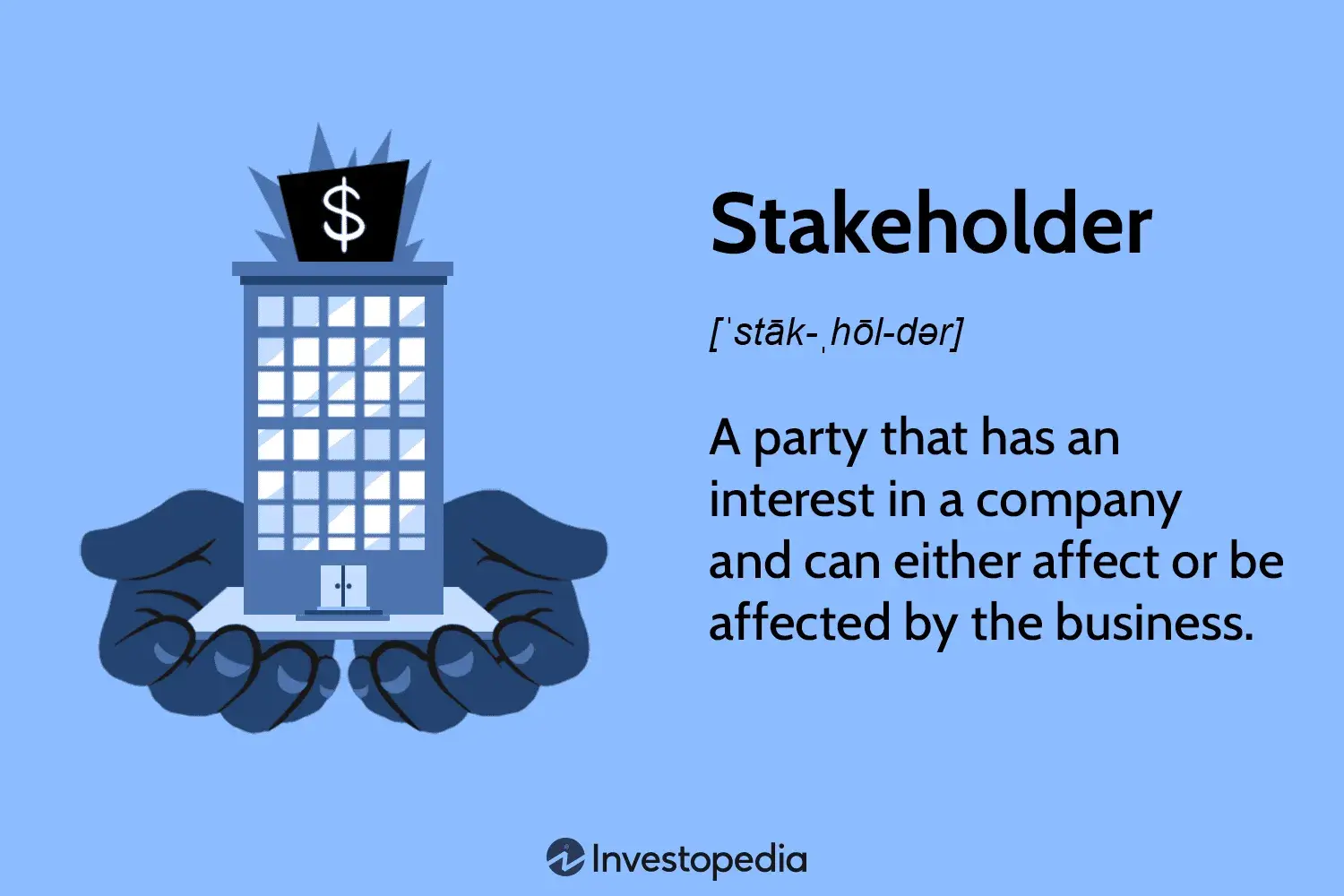
At my agency, I saw how different stakeholders interacted with SOPs, each bringing their own perspective to make the documents more effective. Through this experience, I learned to consider everyone who touches a process.
- Leadership provided a high-level vision for how SOPs should align with business goals.
- Managers helped refine the practices and ensured smooth implementation.
- But most importantly, the ground-level employees (like myself and my fellow writers) provided crucial input about what actually worked in practice.
I discovered that the best SOPs weren't just approved by management — they were shaped by the people doing the daily work.
These were the team members who knew the shortcuts, workarounds, and potential pitfalls that needed to be addressed.
Lastly, don’t forget your customers. While SOPs mainly address internal processes, these operations can significantly impact the customer experience.
Keep your audience in mind and design an SOP that streamlines internal processes and enhances client satisfaction.
Pro tip: Many SOPs fail because they don't include input from front-line workers. While management approval is important, the people doing the actual work should be your primary source of information.
Step 4: Determine the scope and format.
When I started creating SOPs for my writing business, I made the mistake of trying to fit everything into simple lists. It wasn‘t until I experimented with different formats that I found what truly worked for different situations.
The key is to consider who’ll use the SOP and what tools they'll need.
For example, when documenting my research process, I needed more than a basic checklist. I had to consider which databases I use, my note-taking software, and how I organize sources.
This helped me choose a format that covered all the essential elements without becoming overwhelming.
Here are the most effective formats I've encountered.
- Step-by-step written list: Ideal for simple, straightforward tasks.
- Hierarchical list: Useful for complex procedures with many steps and decision points.
- Flowchart: Great for processes with multiple outcomes.
- Simple checklist: Perfect for tasks that need to be repeated consistently.
- Video: Effective for visual learners and demonstrations.
- Interactive course: Engaging and comprehensive for detailed training.
Remember, simpler is usually better. I've found that a basic step-by-step list works perfectly for straightforward tasks, while I save flowcharts for processes with multiple decision points.
Pro tip: Create a rough draft in two different formats and time yourself following each one. The version that takes less time to complete while maintaining accuracy is usually your best choice.
Step 5: Gather information.
In my transition from scattered notes to proper SOPs, I discovered that thorough information gathering makes all the difference.
Rather than just writing down what I thought I knew about my content creation process, I took time to research industry best practices and document my actual workflow.
One eye-opening exercise was timing myself while completing a writing project and noting every step, tool, and resource I used.
I was surprised to find I was skipping steps I thought were essential while regularly using helpful shortcuts I'd never documented.
Here‘s what I’ve found works best:
- Start with research into industry guidelines and best practices.
- Document your current process as you actually perform it.
- Note which tools and resources you rely on.
- Identify potential challenges and bottlenecks.
- Look for ways to incorporate proven strategies from others in your field.
I also review any existing documentation or procedures I have, even if they‘re just rough notes, to ensure I’m not missing any important steps.
Pro tip: Record yourself completing the process while narrating what you're doing. This will help you catch small but important details, like keyboard shortcuts or verification steps, that you might otherwise forget to document.
Step 6: Outline and write the SOP.
When I sat down to write my first serious SOP for my content workflow, I quickly realized I needed a clear structure.
Through trial and error, I learned that organizing the document thoughtfully from the start saves countless revisions later.
Let me walk you through the essential components I now include in every SOP.
- Title page. I make sure to include the basics: a clear title, the date created, and who it's for. For my content creation SOPs, I also add version numbers to track updates.
- Table of contents. For longer SOPs (anything over two pages), I've found that a simple table of contents helps me and others quickly find specific sections when we need them.
- Preparatory information. This is where I list everything needed before starting the process. For my research SOP, this includes required software, database access, and template links.
- Methodology and procedures. This is the heart of the SOP — the actual step-by-step process. When documenting my content creation workflow, I break it down into clear phases: research, outlining, writing, and editing. I include screenshots where they help clarify steps.
- Quality control. I include a checklist of what “good” looks like, helping to ensure consistency every time I use the SOP.
- References and glossary. I keep a small glossary of technical terms and links to related resources. This has proven especially helpful when I need to reference style guides or client requirements.
Pro tip: Write your first draft as if explaining the process to someone who's never done it before. Then, remove any steps that feel obvious to your actual audience. This helps avoid missing crucial details and overexplaining simple tasks.
Step 7: Proofread, test, and revise.
My biggest lesson in creating SOPs came from watching my carefully written instructions fall apart during actual use. I learned that no matter how clear I think my writing is, testing reveals blind spots.
My process now is simple but thorough:
- I proofread for clarity and technical accuracy.
- I run through the process myself, following my own instructions exactly.
- I time each step to ensure the pace is realistic.
- I ask someone unfamiliar with the task to follow the SOP while I observe.
Just last week, timing my content research SOP revealed that I'd drastically underestimated how long it takes to evaluate sources. This led me to add specific criteria for faster source assessment.
Pro tip: When testing your SOP, resist the urge to explain or clarify steps verbally. If you want to add verbal instructions, those details need to be written into the SOP.
Step 8: Implement and regularly update.
At the agency, I saw how SOPs evolved with changing tools and requirements. This taught me that even the best procedures need regular maintenance.
This lesson proved invaluable when I later established my freelance business. What worked six months ago might not be optimal today, especially given how quickly writing tools and requirements change.
Taking what I learned from the agency's review process, I now schedule quarterly reviews of my freelance SOPs.
This practice has helped me catch outdated processes like old keyword research methods that were no longer effective. Regular reviews also help me incorporate new tools and techniques that improve efficiency.
To keep my SOPs current, I:
- Add comments and suggestions right in the document when I notice something needs updating.
- Review each SOP when I adopt new tools or processes.
- Update instructions immediately if I find steps that cause confusion.
- Adjust timeframes and requirements based on changing client needs.
This approach combines the systematic updating I witnessed at the agency with the flexibility needed for independent work. It ensures my processes stay current while maintaining the high standards I learned during my agency experience.
Pro tip: Set a calendar reminder for SOP reviews. During the review, run through the process exactly as written — you'll often find steps that could be streamlined or updated with better methods.
SOP Formats: Choosing the Right Structure for Your Business Processes
In my research into SOP best practices, I connected with Leslie Lulham, chief of staff at MarketerHire, who shared a crucial insight: “The most common reason SOPs fail in practice is that they are not used.”
This highlights a key challenge many organizations face: creating SOPs that don't just document processes but actually drive consistent execution.
Let's explore three essential formats and how they serve different needs.
1. Step-by-Step SOP
Best for: Clear Process documentation
Step-by-step SOPs are detailed guides that outline the exact sequence of actions needed to complete a task. Each step is listed in order, making it easy to follow and ensuring consistency in execution.
“You must go in assuming the end user knows nothing and fully detail the process,” Lulham emphasizes.
This thoroughness transforms a simple procedure into an effective training tool. Clear, detailed steps help new team members get up to speed quickly while ensuring experienced staff maintain consistent quality.
Step-by-step SOPs work best for:
- New employee training.
- High-stakes processes where order matters.
- Tasks with clear, linear progression.
- Processes requiring documentation for compliance.
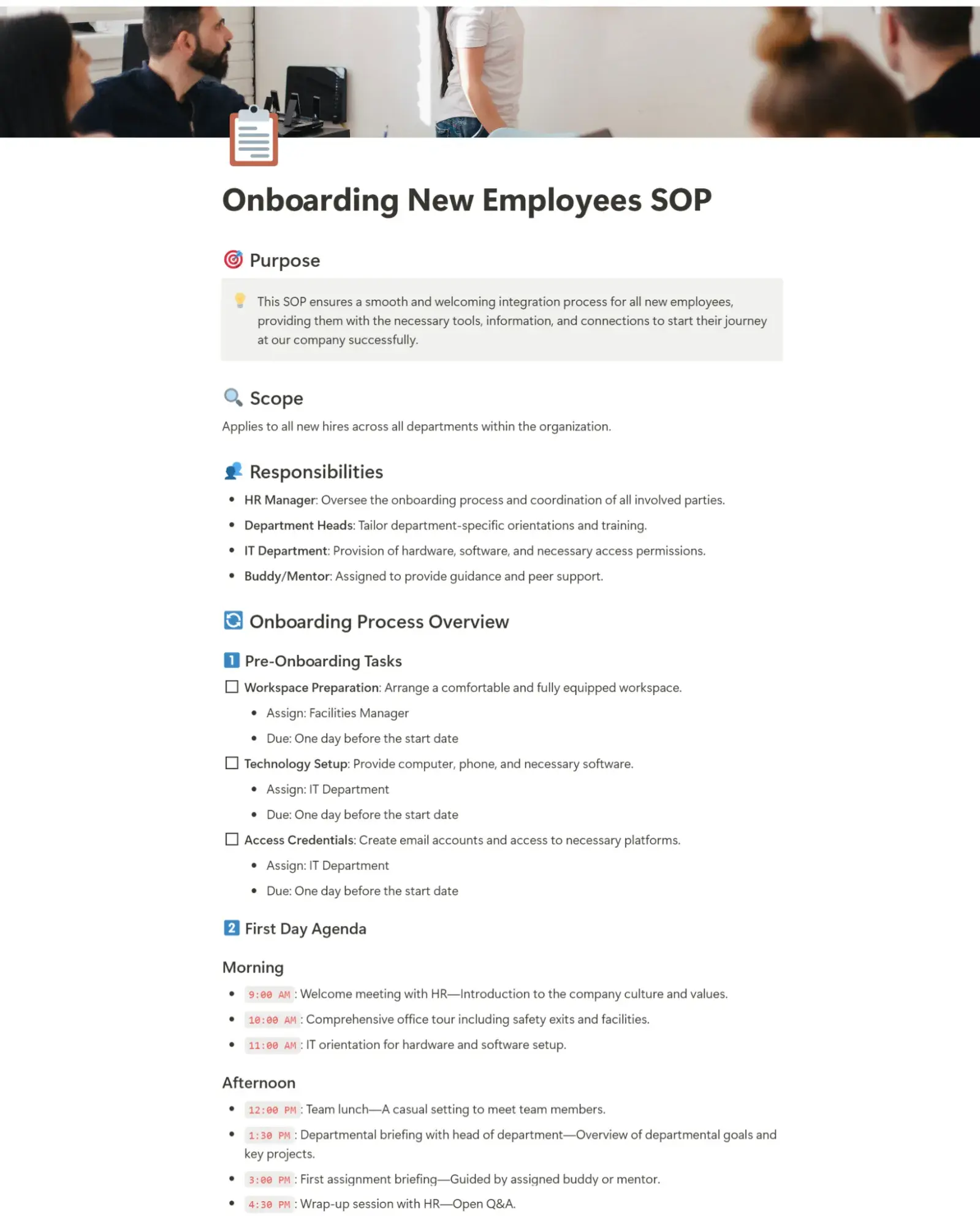
2. SOP Flowcharts
Best for: Mapping complex decision paths
While linear processes benefit from step-by-step documentation, complex decision-making requires a different approach.
Flowcharts map out process steps in a visual sequence, helping users quickly grasp both the flow of tasks and critical decision points.
Lulham offers practical guidance on structuring complex processes: “If any singular step in a flowchart composes multiple actions, it should be broken out into multiple SOPs, which can get hyperlinked back into the original flow chart.”
I like to use the example of the onboarding process for a new contractor. The flowchart might include sending the agreement, setting up email access, and adding them to communication platforms.
Each of these steps involves multiple actions that deserve their own detailed documentation, linked within the main flowchart.
SOP flowcharts are best for:
- Complex decisions with multiple outcomes.
- Customer service scenarios.
- Troubleshooting processes.
- Tasks requiring quick visual reference.
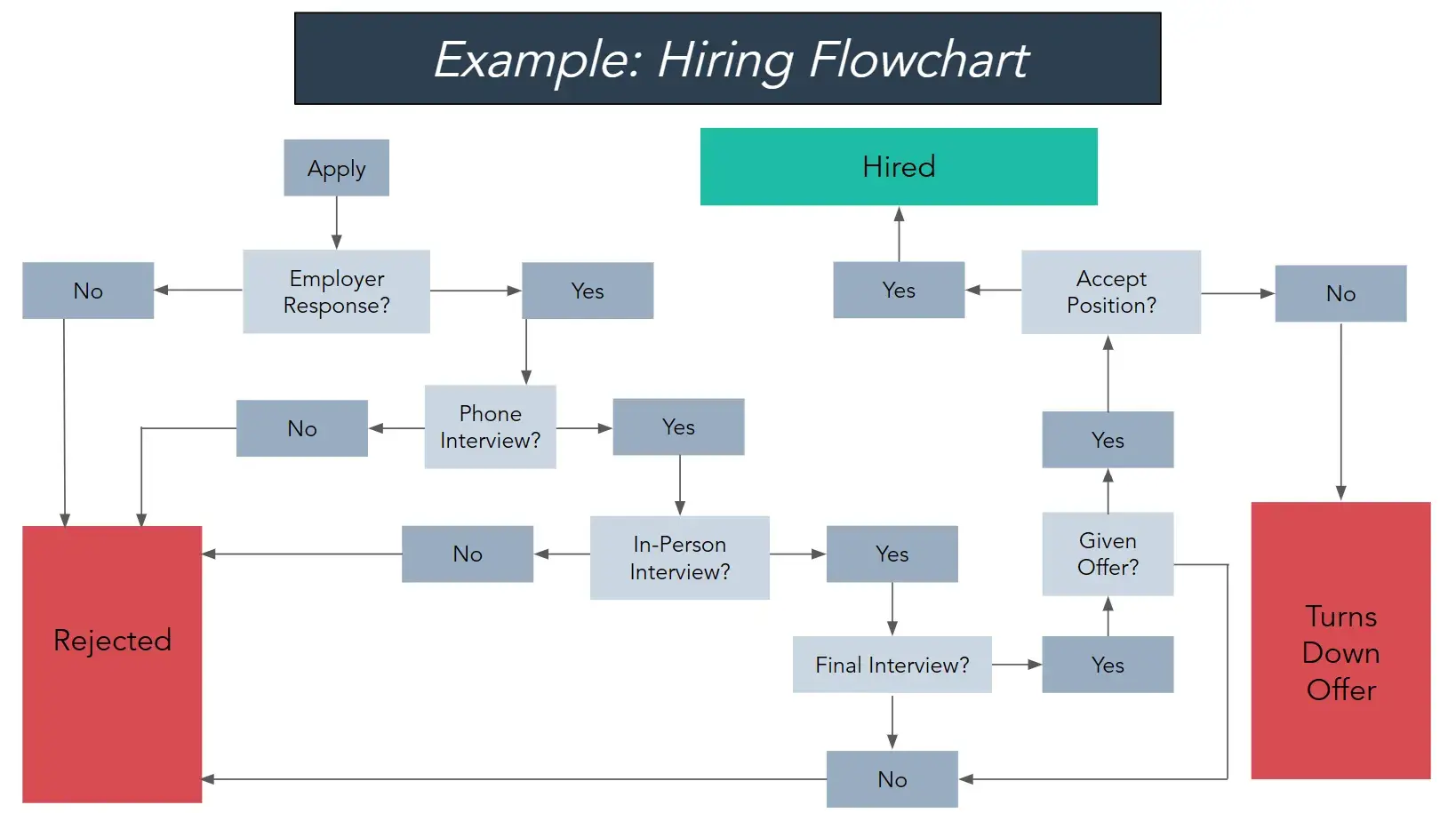
3. SOP Checklist
Best for: Balancing comprehensiveness with usability
Checklists ensure consistency while keeping processes efficient and manageable. Modern checklist design requires a thoughtful approach to user experience.
“I include a 'TL;DR' version at the top,” Lulham shares, describing her innovative approach.
“This is just what someone who has already read the doc will need to refer back to. The rest of the doc will be comprehensive and explain the various steps, why we do the task the way we do, and include screenshots,” she adds.
This two-tier approach serves both new users who need detailed guidance and experienced staff who just need quick reminders. It's particularly effective for:
- Quality assurance processes.
- Regular maintenance tasks.
- Pre-launch verification.
- Safety protocols.
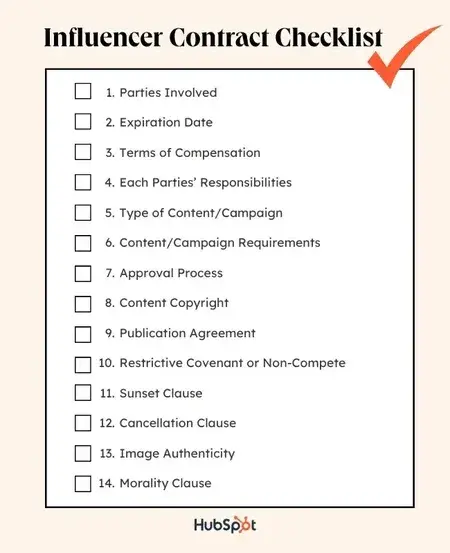
Pro tip: Before selecting a format, map out your process on paper first. I've found this simple step saves hours of revision later, as it helps identify decision points that might need a flowchart rather than a simple checklist.
Benefits of Standard Operating Procedures in Business
Still wondering whether SOPs are a worthy cause? Check out their potential benefits for your business.
- Consistency. SOPs ensure that tasks are done the same way every time, which keeps quality high and errors low. With everyone on the same page, your products or services consistently hit the mark.
- Efficiency. Clear instructions help new hires and seasoned employees complete tasks quickly and accurately. This boost in efficiency has a twofold effect on business operations: it saves time and cuts costs.
- Compliance. In regulated industries, SOPs help ensure tasks are done in compliance with laws and regulations, reducing the risk of legal issues and fines.
- Safety. SOPs outline the right way to perform tasks, which helps prevent accidents and ensures everyone stays safe. This is especially important in fields like manufacturing, healthcare, and construction.
- Accountability. SOPs clearly define who is responsible for each task, making it easier to hold people accountable and ensuring tasks are completed correctly and on time.
- Customer satisfaction. Happy customers are the best customers. SOPs help deliver consistent, high-quality products and services, giving customers the great experience they expect every time. This consistency fosters repeat business and positive word-of-mouth.
Write SOPs That Work For You
Creating this guide brought my own SOP journey full circle.
From resisting structure as a freelancer to embracing it at the agency and then bringing those lessons back to my independent work, it‘s clear now that SOPs aren’t the creativity killers I once feared.
The biggest revelation? Good SOPs don't constrain us; they free us to focus on what matters. By documenting the routine, we create more space for creativity and innovation.
Whether you're part of a large team or working solo like I do now, SOPs can transform chaos into clarity – just start small, focus on what matters most, and let your processes evolve as you learn.
Editor's note: This post was originally published in August 2021 and has been updated for comprehensiveness.
iPaas
.png?width=112&height=112&name=Untitled%20design%20(8).png)

.png)




